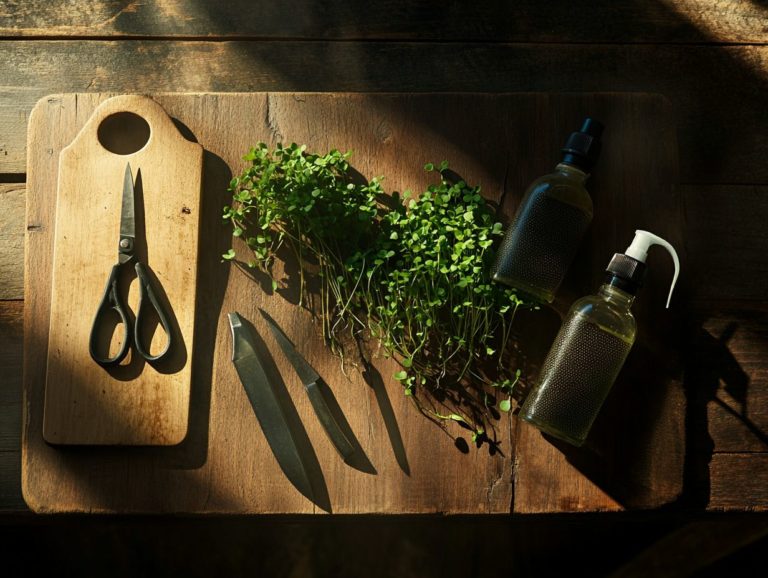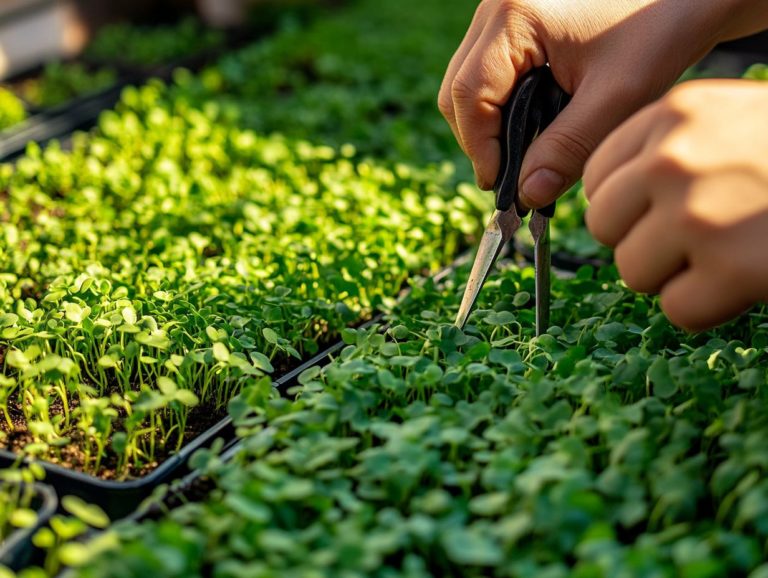How to Store Microgreens for Maximum Nutrient Retention
Microgreens are delightful, miniature greens bursting with flavor and packed with nutrients. They have become a sensation in the culinary world.
In this article, you will delve into what microgreens are. You will explore their numerous nutritional benefits and uncover the key factors that affect their nutrient retention, such as light exposure and optimal storage techniques.
You will find tips for storing these vibrant greens to keep them fresh and potent. Plus, discover creative ways to integrate them into your meals!
Get ready to elevate your cooking with microgreens!
Contents
- Key Takeaways:
- Understanding Microgreens
- Nutritional Benefits of Microgreens
- Factors Affecting Nutrient Retention in Microgreens
- Tips for Storing Microgreens
- Using Stored Microgreens
- Frequently Asked Questions
- What are microgreens and why is it important to store them properly for nutrient retention?
- How should microgreens be stored for maximum nutrient retention?
- What is the ideal temperature for storing microgreens?
- Can microgreens be frozen for storage?
- Is it better to store microgreens in the fridge or at room temperature?
- How can you tell if microgreens have gone bad?
Key Takeaways:
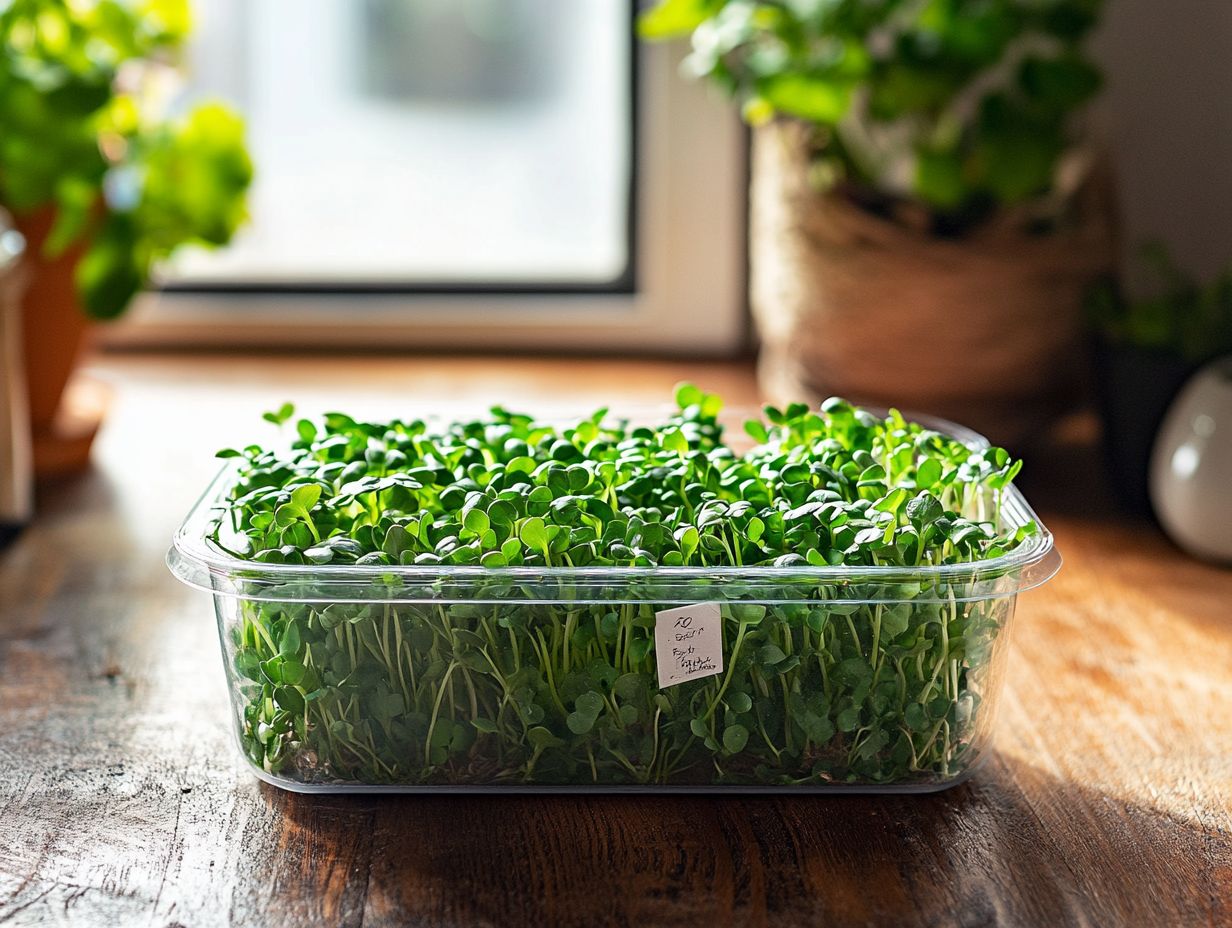
- Microgreens are young, nutritious foods that offer a concentrated source of vitamins and minerals.
- Proper storage is crucial for maximum nutrient retention in microgreens, considering factors like light exposure, temperature, and humidity.
- Using airtight containers, storing them in the fridge, and incorporating stored microgreens into meals helps you enjoy their benefits longer.
Understanding Microgreens
Understanding microgreens is key for anyone passionate about healthy eating and sustainable living. These nutrient-packed young greens are harvested early from various vegetables like radishes, broccoli, and kale, presenting numerous health benefits.
You can easily grow them at home or find them through local farmers and urban farms. Their vibrant colors and flavors not only elevate any dish but also enhance your nutritional intake, contributing significantly to your overall health and wellness.
What are Microgreens?
Microgreens are your ticket to a world of vibrant flavor and nutrition. They are harvested just after the first true leaves appear.
Typically, you gather these young greens within 7 to 21 days of germination, ensuring they have that tender texture and intense flavor that can elevate your dishes. If you re venturing into home growing, consider staples like arugula and mustard greens; their peppery notes serve as beautiful garnishes and delightful additions to salads.
Cultivating fresh microgreens is rewarding and enhances your cooking skills, inviting you to experiment creatively in soups and sandwiches. Their compact size and rapid growth make them an excellent option for anyone keen on home gardening, even in limited spaces.
Nutritional Benefits of Microgreens
Microgreens are not just garnishes; they are nutritious foods, delivering concentrated doses of vitamins and minerals that can elevate your healthy diet.
Incorporating them into your meals adds vibrant flavor and maximizes your nutrient intake.
Key Vitamins and Minerals in Microgreens
Microgreens are a treasure trove of essential vitamins and minerals, making them fantastic additions to your balanced diet. These tiny greens deliver a powerful nutritional punch, offering a diverse array of nutrients that can significantly support your overall health.
Take pea shoots, for example; they are renowned for their impressive vitamin C content, crucial for boosting your immune system and promoting radiant skin. On the other hand, kale microgreens are rich in vitamin K, essential for blood clotting and maintaining bone health. Then there are beet greens, which pack a notable amount of folate, vital for cell function and tissue growth.
By incorporating these nutrient-dense microgreens into your meals, you enhance your intake of key vitamins and minerals, contributing to a well-rounded, healthy lifestyle. Additionally, you can address food waste by utilizing what you grow effectively.
Factors Affecting Nutrient Retention in Microgreens
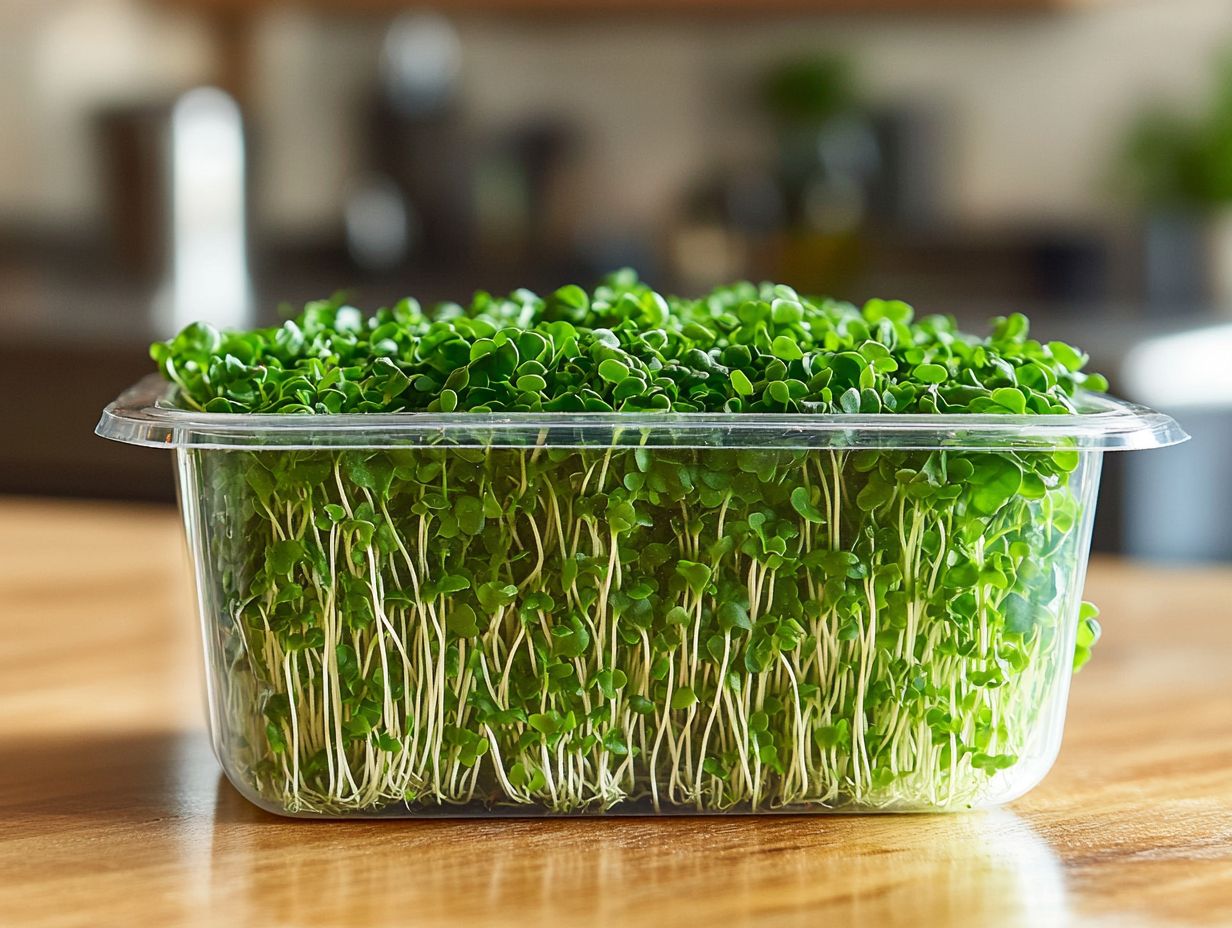
The retention of nutrients in microgreens is shaped by several key factors, including light exposure, temperature, and humidity throughout both the growth and storage phases.
Carefully managing these elements can enhance the nutritional value of your microgreens, ensuring they remain at their peak quality.
Start your microgreen journey today and enjoy fresh flavors at home!
Light Exposure
Light exposure plays a pivotal role in the growth of microgreens, profoundly impacting their flavor profile and nutrient retention.
The intensity, quality, and duration of light can differ significantly between natural sunlight and artificial sources. Each type affects the plants in distinct ways. For example, natural light provides a full spectrum that fosters robust growth and vibrant colors.
Specialized artificial grow lights can be fine-tuned to deliver essential wavelengths that enhance photosynthesis.
It’s crucial to maintain optimal light conditions. Most microgreens flourish with 12 to 16 hours of light each day while avoiding excess exposure to ethylene gas, a natural gas from fruits that can spoil microgreens.
The right lighting encourages stronger plant structures and maximizes their nutrient profiles. This ensures a bountiful harvest rich in vitamins and antioxidants.
Temperature and Humidity
Temperature and humidity are vital in determining both the growth and longevity of microgreens. They directly influence freshness and nutrient retention.
To grow microgreens well, you must maintain an optimal environment. These delicate greens thrive best at temperatures ranging from 60 F to 75 F. Humidity levels should ideally hover between 40% and 60%.
By effectively managing these conditions, you not only promote vigorous growth but also extend the shelf life of your microgreens. This allows you to savor their nutrients for a longer period.
When stored in cooler temperatures within sealed containers, microgreens can preserve their essential vitamins and minerals, significantly enhancing their culinary and nutritional value.
Using proper storage techniques ensures that these vibrant plants remain crisp and flavorful. This reduces waste and optimizes their health benefits.
Harvesting and Storage Techniques
Effective harvesting and storage techniques are crucial for preserving the freshness and shelf life of microgreens after harvesting.
Using a sharp knife guarantees a clean cut and minimizes bruising, which can undermine the quality of the delicate greens. As you handle these vibrant plants, remember to be gentle to preserve their tender leaves and enhance their flavor.
Once you ve harvested them, proper storage methods become paramount. Placing your microgreens in a breathable container in the refrigerator can significantly extend their shelf life.
Managing moisture is key to preventing wilting and decay. By adopting these best practices, you’ll be amazed at how much longer your microgreens last while maintaining their impressive nutritional benefits.
Tips for Storing Microgreens
Storing microgreens with care is essential for maintaining their freshness, nutritional value, and overall quality. This ensures they continue to be a vibrant and healthy addition to your meals.
Proper Storage Containers
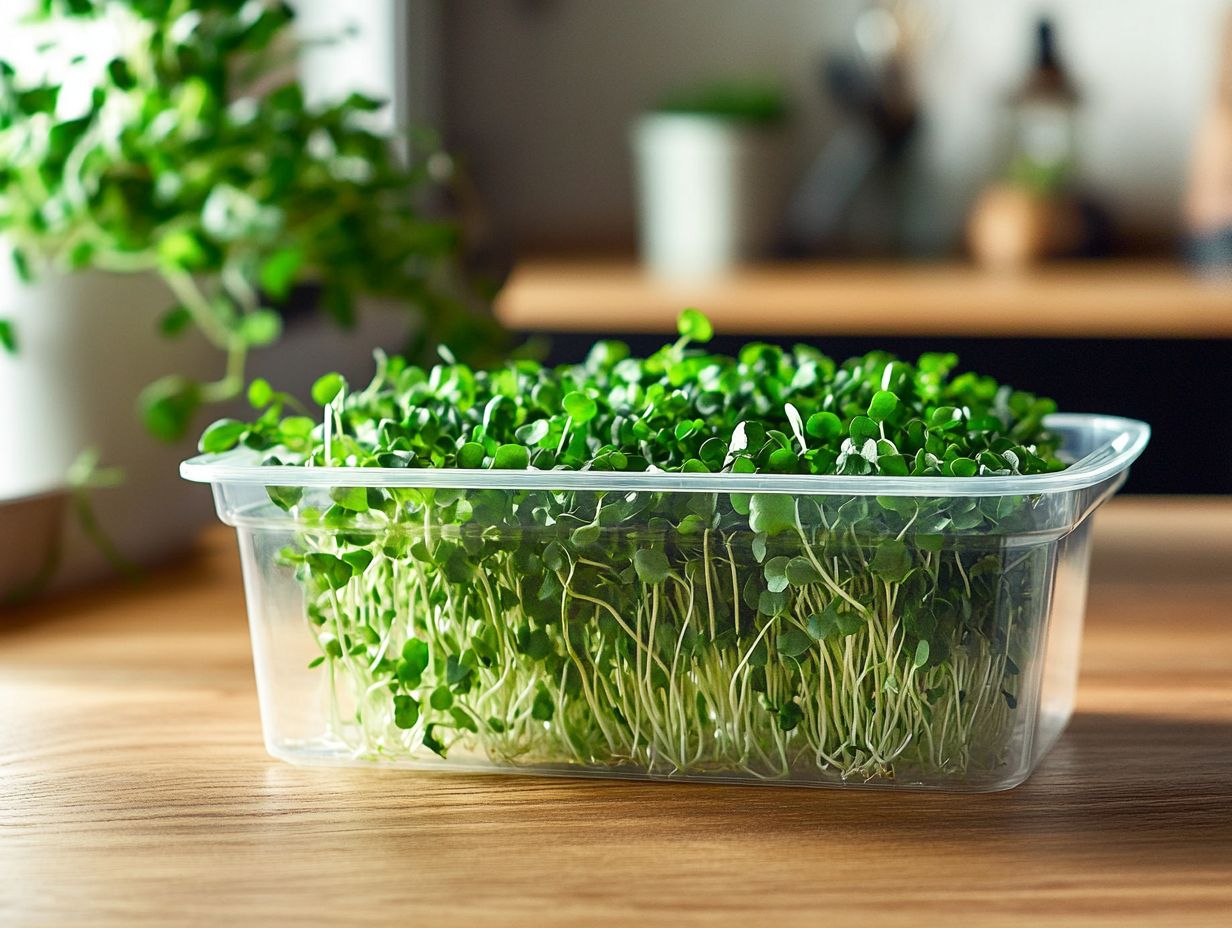
Choosing the right container for your microgreens is essential for preventing spoilage. The container type can significantly impact the preservation of these delicate greens, so consider options that provide adequate air circulation and moisture balance.
For example, opting for perforated trays allows air to flow freely, reducing the risk of mold and mildew while keeping moisture levels just right.
Glass or breathable fabric containers are excellent choices, as they minimize condensation. While using airtight containers may seem practical, they can lead to excess moisture buildup, compromising the quality of your microgreens.
By selecting the appropriate storage solution, you ll extend their shelf life and enhance their flavor and nutritional value.
Best Practices for Storing Microgreens
Implementing best practices for storing microgreens can significantly enhance their shelf life and preserve their nutritional value. This approach ensures that these vibrant little plants stay fresh while maintaining their crisp texture and delightful flavors.
One key aspect to focus on is keeping the refrigerator at the perfect fridge temperature, ideally between 34 F and 38 F. Monitor moisture levels closely, as excess humidity can lead to spoilage. Using breathable containers will help create a balanced environment that supports their longevity. For more details on optimal storage techniques, refer to the best methods for storing microgreens. Handle microgreens gently to avoid bruising and keep them looking their absolute best.
By embracing these strategies, you ll create a favorable atmosphere for prolonged enjoyment of your microgreens!
Using Stored Microgreens
Incorporating stored microgreens into your meals presents a fantastic opportunity to elevate both flavor and nutritional value. This transforms healthy eating into a truly delightful experience!
How to Incorporate Stored Microgreens into Meals
Using stored microgreens can elevate both flavor and nutrition, providing a versatile and healthful enhancement to any dish.
- Picture adding a handful of peppery arugula microgreens to a crisp salad.
- Layer vibrant radish microgreens in a sandwich for that delightful crunch.
- If smoothies are your thing, toss in some nutrient-rich sunflower microgreens to elevate your morning blend without overwhelming the taste.
With an array of varieties offering unique flavors like the earthy essence of beet microgreens or the mild sweetness of pea shoots there s something to satisfy every palate. Experimenting with these greens not only injects boldness into your meals but also delivers a nutritional boost that reinforces the advantages of healthy eating.
Frequently Asked Questions
What are microgreens and why is it important to store them properly for nutrient retention?
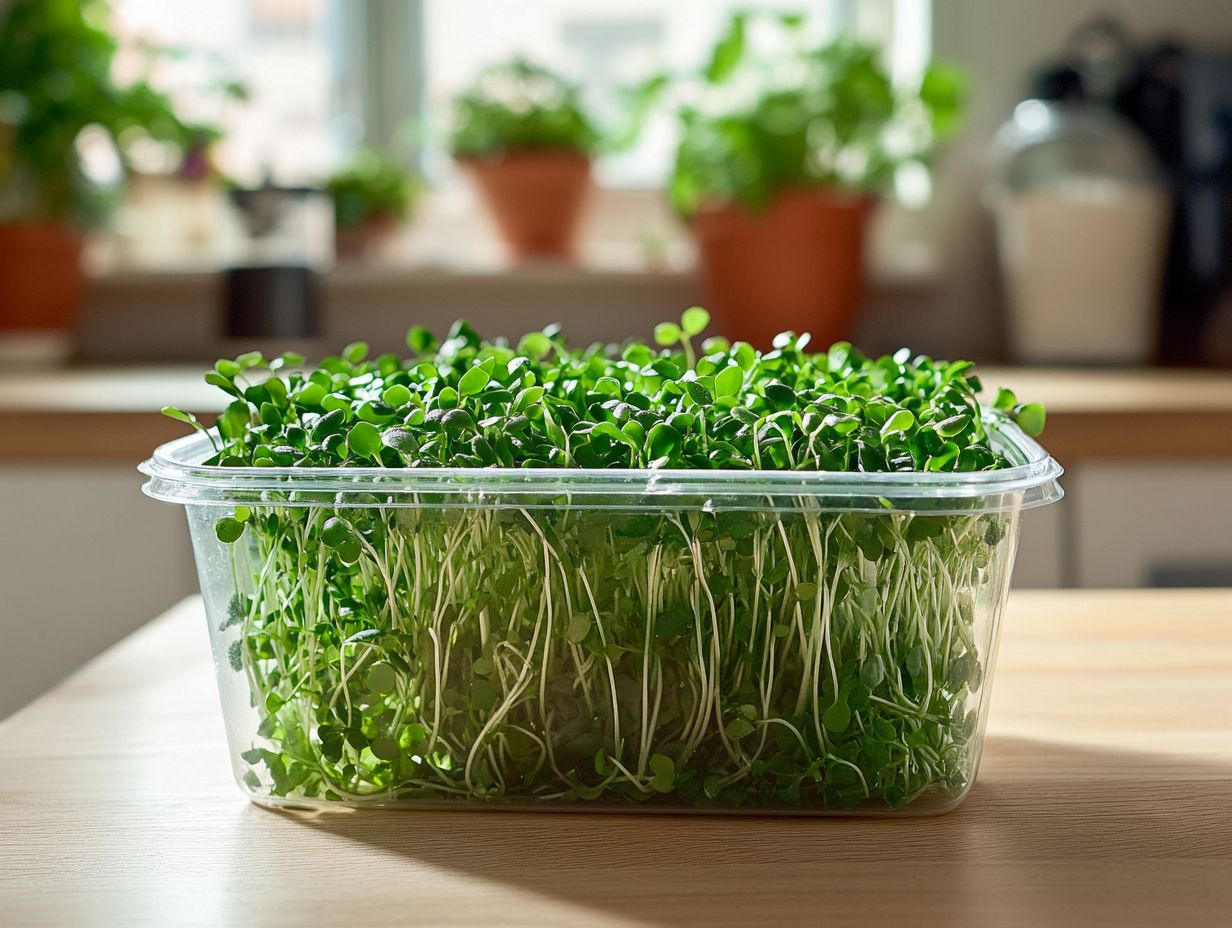
Microgreens are young, edible plants harvested after the first set of true leaves have grown. They are packed with nutrients and antioxidants, making them a popular addition to meals. Storing microgreens properly ensures that their nutrients remain intact and are not lost due to improper storage methods.
How should microgreens be stored for maximum nutrient retention?
The best way to store microgreens is in an airtight container, like a plastic bag or a sealed container. Place a paper towel in the container to absorb excess moisture, then add the microgreens on top. Store them in the refrigerator at 4 degrees Celsius, and they can last up to a week!
What is the ideal temperature for storing microgreens?
The ideal temperature for storing microgreens is between 2-4 degrees Celsius. This helps to slow down the process of wilting and decay, keeping the microgreens fresh and retaining their nutrients for a longer period of time.
Can microgreens be frozen for storage?
Yes, microgreens can be frozen for storage! However, it is important to blanch them before freezing to help preserve their nutrients. Blanching means quickly cooking the microgreens in boiling water, then placing them in an ice bath to stop the cooking process. Once cooled, the microgreens can be placed in an airtight container and stored in the freezer for up to 3 months.
Is it better to store microgreens in the fridge or at room temperature?
It is better to store microgreens in the fridge, as they are sensitive to heat and can wilt quickly if left at room temperature. Refrigeration helps maintain their freshness and nutrients, making them last longer.
How can you tell if microgreens have gone bad?
If microgreens have gone bad, they will appear wilted, slimy, or discolored. They may also have a foul odor. It is important to discard any microgreens that show these signs to avoid consuming spoiled food.

